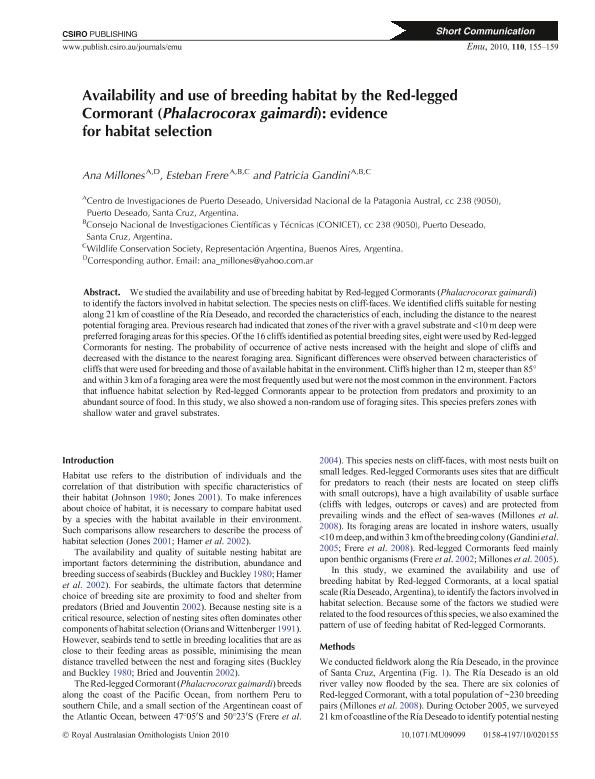Mostrar el registro sencillo del ítem
dc.contributor.author
Millones, Ana

dc.contributor.author
Frere, Esteban

dc.contributor.author
Gandini, Patricia Alejandra

dc.date.available
2020-03-12T20:49:45Z
dc.date.issued
2010-04
dc.identifier.citation
Millones, Ana; Frere, Esteban; Gandini, Patricia Alejandra; Availability and use of breeding habitat by the Red-legged Cormorant (Phalacrocorax gaimardi): Evidence for habitat selection; Taylor & Francis; Emu; 110; 2; 4-2010; 155-159
dc.identifier.issn
0158-4197
dc.identifier.uri
http://hdl.handle.net/11336/99392
dc.description.abstract
We studied the availability and use of breeding habitat by Red-legged Cormorants (Phalacrocorax gaimardi) to identify the factors involved in habitat selection. The species nests on cliff-faces. We identified cliffs suitable for nesting along 21km of coastline of the Ra Deseado, and recorded the characteristics of each, including the distance to the nearest potential foraging area. Previous research had indicated that zones of the river with a gravel substrate and 10m deep were preferred foraging areas for this species. Of the 16 cliffs identified as potential breeding sites, eight were used by Red-legged Cormorants for nesting. The probability of occurrence of active nests increased with the height and slope of cliffs and decreased with the distance to the nearest foraging area. Significant differences were observed between characteristics of cliffs that were used for breeding and those of available habitat in the environment. Cliffs higher than 12m, steeper than 85 and within 3km of a foraging area were the most frequently used but were not the most common in the environment. Factors that influence habitat selection by Red-legged Cormorants appear to be protection from predators and proximity to an abundant source of food. In this study, we also showed a non-random use of foraging sites. This species prefers zones with shallow water and gravel substrates.
dc.format
application/pdf
dc.language.iso
eng
dc.publisher
Taylor & Francis

dc.rights
info:eu-repo/semantics/openAccess
dc.rights.uri
https://creativecommons.org/licenses/by-nc-sa/2.5/ar/
dc.subject
Red Legged Cormorant
dc.subject
Habitat selection
dc.subject
Breeding habitat
dc.subject
Patagonia
dc.subject.classification
Ecología

dc.subject.classification
Ciencias Biológicas

dc.subject.classification
CIENCIAS NATURALES Y EXACTAS

dc.title
Availability and use of breeding habitat by the Red-legged Cormorant (Phalacrocorax gaimardi): Evidence for habitat selection
dc.type
info:eu-repo/semantics/article
dc.type
info:ar-repo/semantics/artículo
dc.type
info:eu-repo/semantics/publishedVersion
dc.date.updated
2020-03-04T17:34:59Z
dc.journal.volume
110
dc.journal.number
2
dc.journal.pagination
155-159
dc.journal.pais
Reino Unido

dc.journal.ciudad
Londres
dc.description.fil
Fil: Millones, Ana. Universidad Nacional de la Patagonia Austral. Unidad Académica Caleta Olivia. Centro de Investigaciones Puerto Deseado; Argentina
dc.description.fil
Fil: Frere, Esteban. Universidad Nacional de la Patagonia Austral. Unidad Académica Caleta Olivia. Centro de Investigaciones Puerto Deseado; Argentina. Consejo Nacional de Investigaciones Científicas y Técnicas; Argentina. Wildlife Conservation Society; Estados Unidos
dc.description.fil
Fil: Gandini, Patricia Alejandra. Wildlife Conservation Society; Estados Unidos. Consejo Nacional de Investigaciones Científicas y Técnicas; Argentina. Universidad Nacional de la Patagonia Austral. Unidad Académica Caleta Olivia. Centro de Investigaciones Puerto Deseado; Argentina
dc.journal.title
Emu

dc.relation.alternativeid
info:eu-repo/semantics/altIdentifier/doi/https://doi.org/10.1071/MU09099
dc.relation.alternativeid
info:eu-repo/semantics/altIdentifier/url/https://www.tandfonline.com/doi/abs/10.1071/MU09099
Archivos asociados
